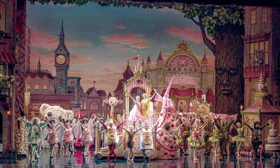Review: American Ballet Theatre's Eye-popping WHIPPED CREAM at Kennedy Center

It must be galling for many ballet companies that their very operation is dependent on extended holiday performances of "The Nutcracker" year after year.
Why can't there be some other pieces that could delight wide audiences in the same way the Sugarplum Fairies do, during other parts of the year?
A strong candidate for that role is Alexei Ratmansky's revived "Whipped Cream" for the American Ballet Theatre, a 2017 delight that is getting its D.C. premiere at the Kennedy Center.
To a supposedly lost ballet score by Richard Strauss and based on an original 1924 Vienna State Opera production called "Schlagobers," the fanciful new version is dominated by a dizzying design by pop surrealist Mark Ryden.
Ryden, whose weird and fascinating art channels the big-eyed paintings of Margaret Keane and weird, smiling imaginary beings like the fuzzy Snow Yak, is right at home in creating the confections and creativity of a world which, as in the Tchaikovsky work, involves a lot of dancing candy.
Here, the protagonist is a young man who, upon his first communion, is dispatched to the confectioner's shop with his friends. But overindulging in whipped cream there lands him in the hospital. The candies all dance after the kids clear out, and a tea queen had to choose between coffee and sugar suitors.
In act two, things turn a bit darker in a hospital scene where a squad of dancing nurses hoist giant hypodermic needles, and a doctor surreptitiously drinks, a trio of dancing liquor bottles (perhaps this is why it's not the optimum childrens' entertainment). Finally, a parade that goes way past pink elephants brings in Princess Praline to help the boy make his escape to her realm - an even more fantastical fever dream of a place where even crazier characters preside.
These characters are all from Ryden's forest of phantasmagorical - giant bees with flapping wings, a 10-foot wizard in a pink robe totem, trees with faces, and the entire cast of the procession: a Snow Yak on all fours with a baby on its back; a Pink Yak walking upright; and a polka-dotted giraffe type creature with wagging ears.
Plus there are all those woozy visions from the hospital: a gumball princess with a gumball gown; a couple of well-appointed walking layer cakes; a human ice cream sundae with a cherry on top; a cylindric Parfait Man; a candy striped worm rolling on stage on her belly, wearing a pointed hat on her head. Plus a handful of actual kids in bouncy cupcake costumes.
It's not all just a fever dream of pink-hued sweetness; his backdrops of peering eyeballs on a field of black brings to mind Salvador Dali's dream sequence in Hitchcock's "Spellbound."
It all works as a singular work of knockout performance art because of every little detail. Ryden designed both the set and the costumes and they come to life with the impeccable work of Camellia Koo (scenic design) and Holly Hynes (costumes).
And I haven't even mentioned the huge headed constructions that serve the grownups in the story, from the carriage driver and sage Pope-like pastor at the country church to the big-headed Chef and especially the grim-looking, big headed Doctor. So detailed are these surreal heads (and apparently light weight enough to be animated by dancers below them) that the Nationals should rethink their happy foam-headed President mascots as more realistic, serious looking historic heads.
Artists from Picasso and Matisse to Hockney have designed for the ballet in the past, but rarely has such a singular vision come to life. How this all makes room for dancing is a good question.
It would seem, at first, that the visual splendor would be the payoff and dance merely the way to comport the fantastic designs on and off stage. But, eventually, Stella Abrera (on opening night) took center state as Princess Tea Flower and began her dances with the big and demonstrative David Hallberg as Prince Coffee, and Blaine Hoven as Don Zucchero, the white-suited royalty from the sugar bowl.
Daniil Simkin, reprising his originating role in the revived work, soared in his dances among the weird procession and with his host Princess Praline, Sarah Lane, also reprising her originating role.
Charles Barker conducted the score which seemed suited to ballet but didn't always have the definitive climaxes to movements that would signal applause for individual scenes.
Ratmansky's choreography stood out in in the intricacies of the beautifully-attired squadrons of dancers, be they the drops of whipped cream refreshingly entering the stage via slide, to the intricate patterns of the marzipan, sugarplum and gingerbread men, battling and intermingling in the confectionary shop.
"Whipped Cream" is being pooh-pooed in some corners for not reflecting all our world's problems. Instead, it's a delight to be allowed entry to this singular vision of a fantastical world, if only for a short time. Bonus: Misty Copland dances Princess Praline Saturday night.
Running time: 100 minutes, with one 20 minute intermission.
Photo credit: Finale of "Whipped Cream" by the American Ballet Theatre. Photo by Gene Schiavone.
"Whipped Cream," by the American Ballet Theatre, runs through Sunday at the Kennedy Center for the Performing Arts, 2700 F St NW. Information online.
Reader Reviews

Videos

